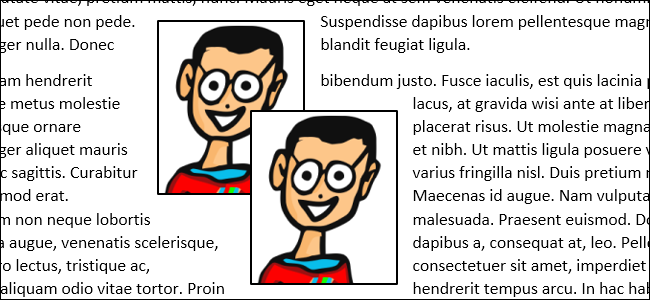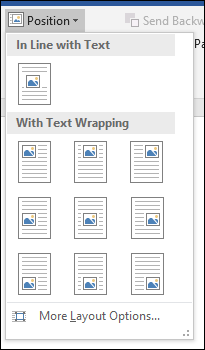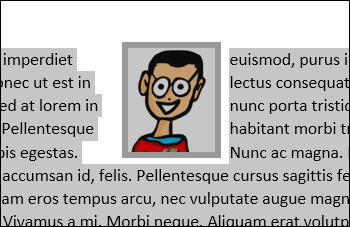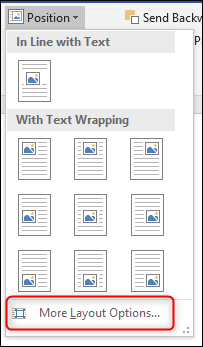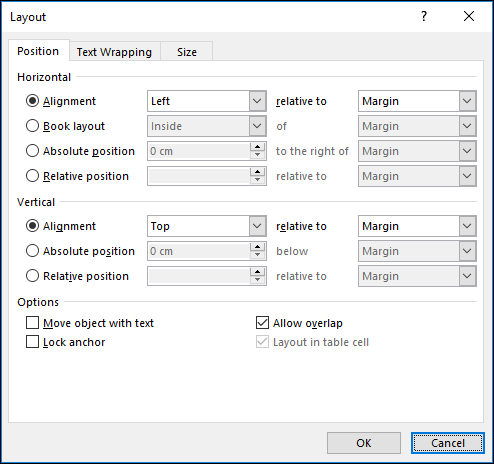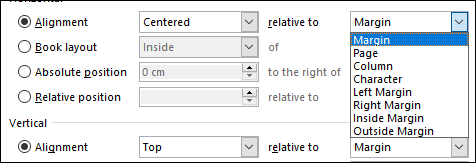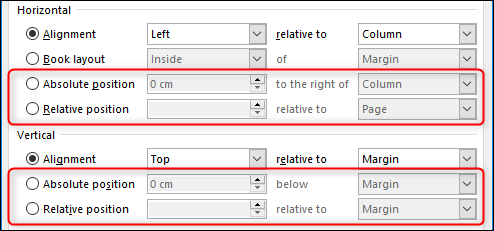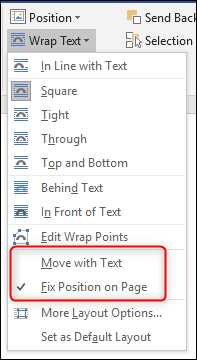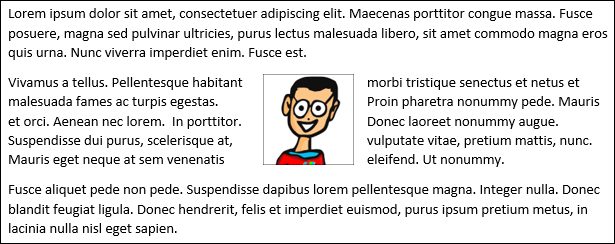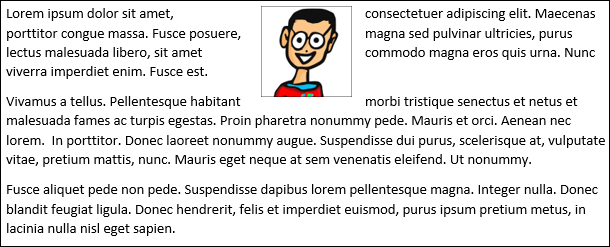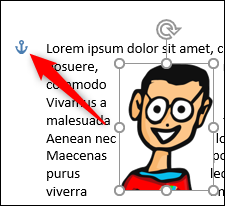Quick Links
Adding an image or other illustration objects to a Word document is simple, but positioning those objects and getting them to stay where you want them can be frustrating. Luckily Word has the tools to make this more manageable if you know where to look. Let's take a quick tour.
A Quick Word About Text Wrapping
Before we get to those positioning tools, though, you should know a bit about text wrapping. By default, when you insert images and other illustration objects into your document, Word applies one of two forms of text wrapping: "in line with text" (for images and most other illustration objects) or "in front of text" (for shapes and 3D models).
When you set an object's text wrapping to be in line with text, Word treats the object in question as a text character. If you type or paste text before or after the object, it moves along the line and down the page just like any other text character. When you set an object's text wrapping to be in front of the text, the object appears on top of any text, and you can move it to any position you want.
Understanding how to wrap text around objects is an important part of getting objects positioned the way you want, so if you're not already familiar with how it works, we highly recommend you read our guide on the subject.
In this article, we're using an object for which we've set the text wrapping to "square." The positioning tools we'll be talking about apply to whatever type of text wrapping you're using, but the exact positioning you're able to perform will depend on what text wrapping you've chosen.
Opening and Using the Position Menu
With that out of the way, let's talk about those positioning tools.
In your document, select the object with which you want to work, switch to the "Layout" menu, and then click the "Position" button. That button also appears on the "Format" menu of the Ribbon and works the same way.
The Position drop-down menu is divided into two sections: "In Line With Text" and "With Text Wrapping."
The "In line with text" section only offers the single default option, and here's what that looks like.
The nine options in the "With Text Wrapping" section let you select a fixed position on the page for your object, ranging from the top left corner to bottom right corner. Here's our image with the "middle top" option selected.
Now that we've selected a position our image will stay there no matter how the text changes. You can delete text from that paragraph, rearrange paragraphs, add new text, or whatever else you need to do and that image will remain at the position you selected.
One thing to be careful with, however, is that selecting the entire paragraph to which the object is anchored will usually select the object as well. So, if you select and then delete that paragraph, you'll delete that object, too. You can see that an object is selected because it takes on a gray color and border.
If you want to delete the paragraph without deleting the object, you can select the whole paragraph and then Ctrl-click the object to deselect it. Deleting the paragraph will then leave the object behind.
You can also drag an object to a new location, and it will stay fixed in that new location.
Fine Tuning and Other Options for Precise Positioning
These basic presets work well for simple positioning, and you can drag your object to a specific place if you want. But what if you want to place two images a set amount apart, or keep your image a particular distance from the margins? Word provides a palette of options you can use to fine-tune an object's position.
Select your object, head back to Layout > Position, and this time click the "More Layout Options" command.
The Layout window should open with the "Position" tab selected.
Here you can customize to your heart's content. Let's take a look, starting with the Alignment options. These two options (one for horizontal and one for vertical alignment) control how the object is aligned in relation to parts of the document. We set our image to the middle top of the page previously, and you can see that choice reflected in the image below with the horizontal alignment set to "centered" and the vertical alignment set to "top"---both measurements relative to the margin of the page.
If you want those alignments measured relative to something other than the page margin, you can choose different options from the drop-down menus to the right of each option.
In the "Horizontal" section, you'll also see a "Book layout" option, which is used when your document is in a left page/right page format for printing and binding. The options here are quite simple. You can position your object relative to either the inside or outside of the margin or page. These options work in tandem with the Layout > Margin options, especially the "Mirrored" option.
Completing the set are "Absolute position" and "Relative position" in both the "Horizontal" and "Vertical" sections. These options give you much finer control over the specific position of an object. Choosing an "Absolute position" means your object will stay in that exact position no matter what other formatting or text you might change. A "Relative position" means your object will be placed relative to a part of the document's structure so if that part of the document moves, your image moves with it and stays in the same relative position. This is useful when you want your image to always be a certain distance away from a margin, for example, even if you change the margin later on.
Overlapping Your Images
Underneath the "Horizontal" and "Vertical" sections in the Layout window, you'll also find a few other options. Let's start with the "Allow overlap" option because that's pretty simple and also very useful.
If you've got more than one object in your document and you want some to be able to overlap with others, you need to---you guessed it---enable the "Allow overlap" option. This is a "whole document" setting, which means it affects every object in the document, not just the object that you had selected when you turned the setting on. This makes a lot of sense if you think about it, because why would you ever turn this on for one image but no others? Like all positioning options, "Allow overlap" only applies to images which aren't using the "In line with text" wrapping style. Once you've turned it on you can drag your images around to overlap how you want.
If you want to change which image is in front of the other, switch to the "Layout" (or "Format") tab and use the "Bring Forward" and "Send Backward" options to layer the images the way you want.
Understanding the "Lock Anchor" and "Move Object With Text" Options
The various horizontal and vertical alignment options (and the "Allow Overlap") are pretty straightforward, especially after you've played with them a bit and seen the effect they have on positioning.
The "Move Object With Text" and "Lock anchor" options, on the other hand, often cause some confusion, so we'll take a bit more time to explain how they work.
First things first: When you start experimenting with these two options, you might notice that not much happens no matter which you choose. That's because these options only affect objects that don't have a fixed position. When you changed your image from "In line with text" to a different text wrapping style, a setting was enabled that you probably missed unless you explicitly looked for it. This setting is called "Fix Position on Page," and you can find it on the Layout (or Format) > Wrap Text menu.
When you have the "Fix Position On Page" option turned on, the "Move object with text" and "Lock anchor" options in that Layout window don't do anything. Those options only work if the image is allowed to move. To use them, you have to turn on the "Move With Text" option instead.
And that's where the confusion usually sets in. The "Move With Text" option on the Wrap Text menu is not the same as the "Move Object With Text" option in the layout window.
So, go ahead and enable the "Move With Text" option on the Wrap Text menu and then return to the Layout window.
Let's start with the "Move Object With Text" option. This setting determines whether the object will move with the paragraph to which it's anchored. If this setting is switched on, you can add or delete paragraphs above the one containing your object and the object moves along with its own paragraph.
A quick example will show this in action. We'll start with an image in the text, set to the "Square" text wrapping option and the "middle top" position.
When "Move object with text" is turned on, the image stays with the original paragraph when we add another paragraph above.
But when "Move object with text" is turned off, the image stays where it is on the page when we add another paragraph above.
This brings us to the way that Word marks an object as belonging to a particular paragraph---how it knows to move the object with the paragraph when "Move object with text" is turned on. Word does this by using an "anchor." You can see the anchor when you select an image.
Note: If you can't see the anchor then go to File > Options > Display and make sure "Object anchors" is switched on.
By default, the anchor is attached to the paragraph you into which you insert the object, but when you move the object to another paragraph, the anchor moves with it. Let's say you have two paragraphs: paragraph one and paragraph two. If your object is in paragraph one and "Move object with text" is switched on, your image will move along with paragraph one. If you drag your object into paragraph two, the anchor becomes attached to paragraph two, and then the object will move along with paragraph two.
But what if you wanted your object to stay in the same position on a page, but always be on the page with its anchor paragraph?
This is where the "Lock anchor" setting comes in. When you turn on "Lock Anchor," you can then move your image to any position on the same page as the anchor paragraph, and the object will stay in that position. However, if you move the anchor paragraph to another page, the object will also move to that page, but stay in the same relative position on the page.
So, for example, if you had your object in the center top of the page and you moved the anchor paragraph to another page, the object would also move to the same page where you moved the anchor paragraph, but remain at the top center of that new page.
That covers image positioning in all its glory, so next time someone dismisses Word as just a glorified typewriter that can't handle images properly, you'll know that they're wrong. So, so wrong.

